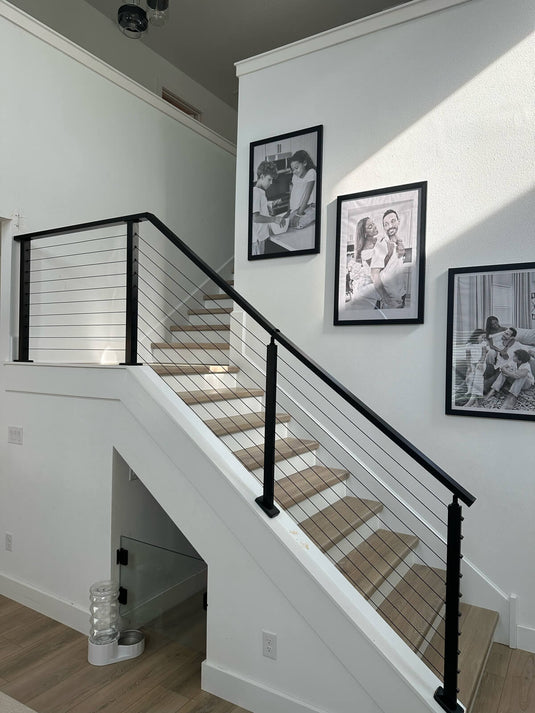TABLE OF CONTENTS
How to Create Modern Floating Stairs?
In contemporary architecture, nothing quite encapsulates elegance like modern floating stairs. These architectural marvels, seemingly suspended in mid-air, offer a minimalist yet striking feature to any home. With various styles and materials, particularly the warm appeal of floating wood stairs, they defy traditional design norms and open up a realm of creative possibilities. This article will show you the intricate process of designing and constructing your own floating stairs, offering practical guidance to bring the sleek sophistication of a floating stairs design into your living space. Whether you're an avid DIY enthusiast or planning to collaborate with professionals, we'll ensure you have all the insights needed to elevate your home with this stunning feature.

Planning and Design Considerations for Modern Floating Stairs
Before embarking on the construction of modern floating stairs, careful planning is essential to ensure the end result is both stunning and structurally sound. This phase is all about aligning your vision with practical considerations to create a floating staircase that enhances your home's design while adhering to safety standards.
Assessing Your Space
Firstly, evaluate the location where you wish to install the floating stairs. Consider the stair's orientation, the available space, and how it will affect the flow and functionality of your home. Remember, floating stairs design isn't just about connecting two floors; it's an opportunity to make a statement.
Safety First: Compliance with Building Codes
Safety is paramount. Research local building codes to understand the requirements for residential staircases, including tread depth, stair width, and load-bearing capabilities. Compliance ensures that your floating stairs are not only visually appealing but also safe for everyday use.
Aesthetics Meets Function
Choosing a style that complements your home's existing decor is key. Floating wood stairs, for instance, can range from sleek, dark walnut to light, Scandinavian-style oak. The design should seamlessly integrate into your home's aesthetic while standing out as its own piece of art.
Material Matters
When selecting materials, consider the overall design theme of your house. Are you going for a modern, industrial look or a more natural, earthy vibe? The choice of material will significantly impact the maintenance, durability, and feel of your floating stairs.
Customization for Uniquity
Finally, think about customization options like LED lighting under the treads or glass side panels. These elements can turn functional floating stairs into a dynamic feature at night, enhancing the ambiance and safety of your home.
Choosing Materials for Floating Stairs
The selection process is crucial, as different materials not only imbue various aesthetic qualities but also come with their own maintenance requirements and lifespans.
Options
1. Wood Floating Stairs:
Floating wood stairs are a popular choice due to their timeless appeal and versatility. Hardwoods like oak, maple, or walnut can provide durability and a rich finish. Softwoods might offer cost savings but tend to be less durable. Each wood type has a unique grain and color, providing ample customization options to match any interior design scheme.
- Pros: Warm aesthetic, versatile styles, can be refinished
- Cons: Can be prone to scratches, may require more maintenance than other materials
2. Metal Floating Stairs:
Metal floating stairs provide a sleek, modern look and are often used in combination with wood or glass. Steel is the most common metal used, offering strength and stability.
- Pros: Durability, sleek industrial look, low maintenance
- Cons: Can be expensive, limited color options without additional finishes
3. Glass Floating Stairs:
For those seeking an ultra-modern vibe, glass treads can be stunning. They can make small spaces appear larger and are usually paired with metal or wooden handrails for added contrast.- Pros: Visually striking, open up space, easy to clean
- Cons: High cost, can be slippery, requires frequent cleaning to maintain appearance
4. Concrete Floating Stairs:
Concrete is a great option for an industrial look and is very customizable in terms of shape and tinting. It's also highly durable and fire-resistant.
- Pros: Industrial aesthetic, fire-resistant, highly durable
- Cons: Heavy, which may require additional structural support, can be cold underfoot
Floating Wood Stairs
Given the popularity of floating wood stairs, let's discuss this material choice in more detail. When selecting wood, consider the following:
- Hardness: The Janka hardness test helps determine the durability of wood. The higher the rating, the more resistant the wood is to wear and tear.
- Finish: From matte to high gloss, the finish will affect both the stairs' look and its slip resistance.
- Color: Think about how the color of the wood will work with the rest of your room. Would a dark stain to match the furniture be best, or a natural finish to highlight the wood's grain?
- Sustainability: If environmentally friendly options are important to you, look for woods certified by organizations like the Forest Stewardship Council (FSC).
Your choice of materials will impact not only the aesthetics and comfort of your floating stairs but also their functionality and longevity. With floating wood stairs, you get the benefit of natural beauty along with the adaptability to suit multiple design preferences, making them a standout selection for many homeowners.
Maintenance Tips for Floating Stairs
Once your modern floating stairs are beautifully installed and integrated into your home's design, maintaining their condition and safety becomes the next essential step.

Routine Cleaning
- Regular Dusting: Use a soft cloth or a feather duster to remove dust from the treads and handrails to prevent buildup.
- Weekly Vacuuming: For floating wood stairs, use a vacuum with a soft brush attachment to carefully clean between treads and around supports.
- Spot Cleaning: Immediately clean spills or stains to prevent damage to the wood finish.
Periodic Deep Cleaning
- Thorough Washing: Use a mild cleaner suitable for wood or the specific material of your stairs. Avoid harsh chemicals that can strip finishes or corrode materials.
- Polishing Wood: Apply wood polish or conditioner to enhance the shine and protect the surface of your floating wood stairs. Ensure the product is appropriate for the type of wood and finish.
Inspect Structural Integrity
- Annual Checks: At least once a year, inspect the structural elements of the staircase. Look for any loose fittings, weakened supports, or signs of wear in the treads and railings.
- Professional Inspection: Consider hiring a professional to inspect your floating stairs every few years to ensure all aspects meet safety standards and structural requirements.
Address Wear and Tear
- Repair Scratches: For wooden stairs, use a matching wood marker or crayon to fill in scratches. Deeper gouges may require sanding and refinishing.
- Tighten Fixtures: Regularly check and tighten bolts and screws, especially in high-traffic staircases.
Protective Measures
- Use Rugs at Entry Points: Place rugs at the foot and top of the stairs to reduce the amount of dirt and debris tracked onto the steps.
- Non-slip Applications: If slipping is a concern, especially in homes with children or elderly members, apply non-slip treads or finishes.
Special Considerations for Floating Wood Stairs
- Humidity and Temperature: Keep indoor humidity and temperature levels consistent to prevent warping or splitting of wooden treads.
- Sunlight Exposure: If possible, shield your floating wood stairs from prolonged direct sunlight to prevent fading and drying out of the wood.
Making Great Spaces with Modern Floating Stairs

Modern floating stairs epitomize elegance and innovation in contemporary architecture, transforming ordinary spaces into striking design statements. By meticulously planning and selecting the right materials, such as wood, metal, glass, or concrete, homeowners can customize a staircase that not only complements their interior decor but also meets safety standards. From choosing sustainable wood to integrating state-of-the-art design features like LED lighting, every decision enhances both the functionality and aesthetic appeal of your home. Regular maintenance further ensures that these stunning architectural features remain safe and beautiful for years to come. Ultimately, modern floating stairs are a central piece of art that reflects personal style and architectural vision.




